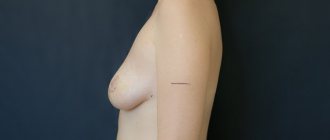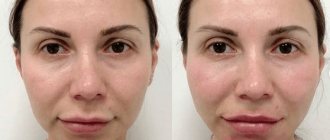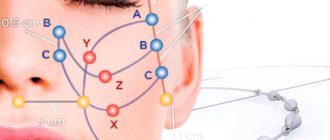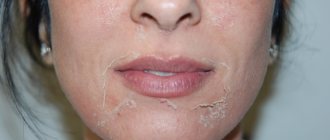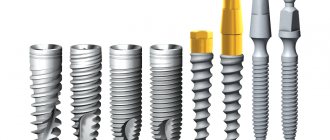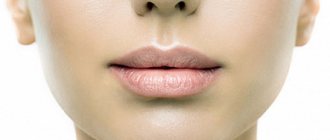Indications for facelift:
- wrinkles (including deep ones);
- sagging, excess skin;
- “swollen” facial contours;
- loose, stretched skin.
Facelift can be carried out both on the entire face and on individual areas. As a rule, a facelift is performed zonally:
- in the upper third of the face (forehead and temporal region);
- in the middle third of the face (temporal, zygomatic and mandibular regions);
- in the lower third of the face (mandibular, chin and cervical areas).
A circular facelift is performed by surgically affecting the soft tissues of the face. During this operation, small incisions are made in the occipital and temporal areas, after which they are sutured so as to relieve the patient of sagging and stretched areas of skin. Typically, this operation is performed after 40 years, when a woman begins to experience significant skin changes that require proper correction. The price for a circular facelift procedure depends on the area being operated on and its total area.
It is possible to combine different zones - the choice depends on the individual characteristics of the patient and his personal wishes.
Rehabilitation after surgical facelift
The rehabilitation period in plastic surgery ensures the success of the operation by 50%: I never tire of repeating this to my patients and talking about it in my articles. Failure to follow your plastic surgeon's recommendations during the rehabilitation period can cause complications and negatively affect the outcome of the operation, so take these recommendations seriously and try to ensure 100% compliance. Doctors often play it safe, but it’s better to play it safe and get an excellent result than to miss something.
Depending on which lifting technique was used by the surgeon and which area of the face was affected by the operation, the doctor’s recommendations may be different, just as the postoperative periods may be different. Rehabilitation after a surgical facelift is the most difficult and lengthy, since the area of intervention is large and a fairly large area is injured.
Rehabilitation after a circular tightening of the skin and muscles of the face is divided into several stages:
- Within 1-2 days after the operation it is necessary to spend in a hospital under the supervision of a doctor.
- After discharge, the next day you need to wash your hair in a special way . I give recommendations for washing your hair upon discharge. The fact is that before the operation, certain areas of the scalp are smeared with a special glue, and I explain in detail how to remove this glue.
- During outpatient rehabilitation, it is necessary to follow the doctor's instructions; Painkillers and antibiotics are prescribed as needed. Taking prescribed medications is strictly required !
- Basic rehabilitation lasts about 1 month, for which you receive individual recommendations. The final result of the operation can be assessed only 6 months after the operation : that is when all the swelling will finally go away and the stitches will heal. Skin sensitivity is fully restored within 1-6 months, and by the end of the rehabilitation period, the skin will no longer need special care and you can return to your usual ways of caring for it.
Recommendations for the rehabilitation period after a facelift
Forbidden:
- Visit a sauna, steam bath, solarium - for 1 month
- Stay in the open sun without protection (cap visor, hat brim, sunscreen)
- Exercise for about 1 month
- Dye your hair and get a perm - for 1 month
- Do manual facial massage – 1 month
- Use masks, peelings and other cosmetics other than those recommended by a doctor.
It is recommended to limit alcohol consumption for a period of 2-3 weeks.
You should treat the stitches promptly and correctly and wear a mask or elastic bandage.
Cost of surgical facelift:
- Face and neck lift - 185,000 rub.
- Forehead lift - 150,000 rub.
- Upper 2/3 of the face (temples) - 140,000 rub.
- Lower 2/3 of the face (neck) - 140,000 rub.
- Chin liposuction (if done simultaneously with facelift surgery) - 20,000 rubles, separately - 30,000 rubles.
- Eyebrows (incision above the eyebrow) - 50,000 rub.
- Eyebrows (incision in the scalp) - 130,000 rub.
- Consultation - 1,000 rub.
- The cost of anesthesia is determined on the day of consultation and depends on the volume of the operation.
Facelift. Works of plastic surgeon Alexander Panaetovich Panaetov:
If you have any questions, you can ask them in the “question-answer” section.
You can make an appointment for a consultation with plastic surgeon A.P. Panayetov in Moscow by phone (viber, whatsapp) or through the feedback form on the website:
Circular facelift: preparation and implementation
Like other types of surgical intervention, facelift is carried out only after an examination, during which the doctor is convinced that there are no contraindications.
It is recommended that two weeks before surgery you stop drinking alcohol, smoking and taking drugs that affect blood clotting (in particular, aspirin).
A circular facelift is performed through microscopic incisions along the edge of the face: through them, the surgeon removes excess skin tissue and fatty tissue. At the final stage, cosmetic stitches are applied. The operation can last up to 5 hours: facelift is almost a jewelry job that cannot be rushed.
How to deal with scars after a circular lift using pharmaceutical products
To make scars invisible, you need to use creams, ointments and gels. The following are considered effective :
- Dermatix - silicone gel and plates are suitable for the early postoperative period, when it is necessary to prevent the formation of a scar at the incision site. Apply twice a day, duration of use is at least 2 months.
- Imoferase - removes an already formed scar, prevents its growth, the first results will be noticeable only after 4 weeks of use. The total duration of the course is 2–3 months.
- Contractubex - this cream contains onion extract, it has a strong anti-inflammatory effect. Not suitable for old scars. A noticeable effect on fresh scars appears after 2 months of continuous use.
Particular attention should be paid to Fermenkol gel. It is able to get rid of scars and fibrosis in the deep layers of the skin. Gives positive results even with old scars. Doctors emphasize that Fermenkol gel should be used 2-3 weeks after surgery, when the wounds have completely healed. Application is simple - the gel is applied in a thin layer to previously cleansed dry skin and left until completely absorbed.
General recommendations after facial plastic surgery
- During the rehabilitation period, you cannot dye your hair.
- Baths, saunas, and sports activities are excluded for two months.
- It is advisable to avoid intimacy for 2 weeks, because this increases blood pressure.
- For 2 months you cannot swim in the pool or open water, do massage, or sunbathe. The face should be protected from direct sunlight.
- After a facelift, the skin will feel tight, this is normal. It is necessary to try to limit facial expressions in order to reduce the load on the skin and facial muscles.
- In the first 2 weeks, in order to reduce the load on the masticatory muscles, you need to follow a diet. It includes pureed and liquid food.
What tests will be required before facial plastic surgery?
Before the operation, the patient must undergo a complete medical examination to identify general health and possible contraindications. The minimum list of necessary preoperative studies includes:
- General blood analysis.
- Biochemical blood test (total protein, ALT, AST, total bilirubin, creatinine, urea, glucose, electrolytes).
- General urine analysis.
- Analysis for blood group and Rh factor.
- Blood test for HIV, syphilis and hepatitis B and C (HBsAg, HCV).
- Blood test for coagulogram.
- ECG.
- Fluorography.
The therapist gives a conclusion about readiness for surgery. If there are concomitant diseases, then consultation with a specialized specialist will be required. To prepare for anesthesia, you will need to visit an anesthesiologist.
Cosmetology and drugs
Cosmetic procedures or various medications can also help speed up recovery after facial plastic surgery. For example, to quickly relieve swelling and bruising, microcurrent or electrostatic lymphatic drainage is recommended. Ultraphonophoresis, plasma lifting and other procedures also work well.
Ultraphonophoresis is one of the procedures recommended after facial plastic surgery.
As for medications, at first the doctor may prescribe painkillers if the pain is too severe and causes significant discomfort to the patient. With open access techniques, antibiotics may also be prescribed to prevent the development of infection. Vitamins and medications that accelerate the resorption of bruises and the tightening of scars will be useful. But it is important to remember that self-prescribing medications or procedures is prohibited!
What should you expect after correction?
The main thing that the patient has to face is external consequences, primarily bruises and swelling. The appearance of bruising and swelling is inevitable for any operation, since tissue is damaged during any intervention. Therefore, you should not be afraid when you see bruises or swelling on your face - this is a normal phenomenon that accompanies any intervention in the postoperative period.
During this period, so-called “floating” swelling can also be observed, when in the evening there is a decline in swelling, and in the morning it appears again. Some patients do not easily accept this from a psychological point of view. The effect can last for several months. It is important to understand that the phenomenon is temporary and will gradually go away on its own.
The appearance of edema is an ordinary satellite of plastic correction.
